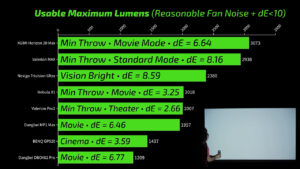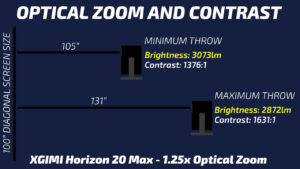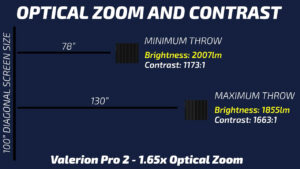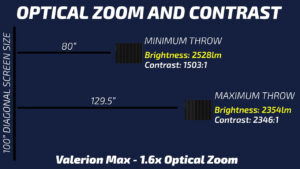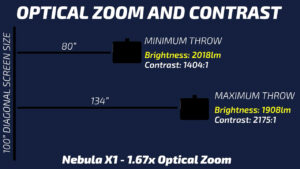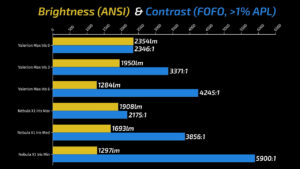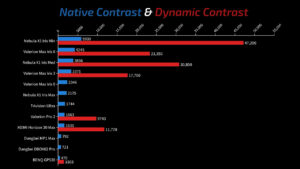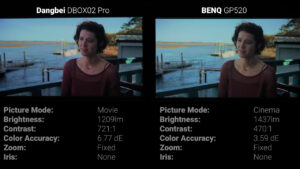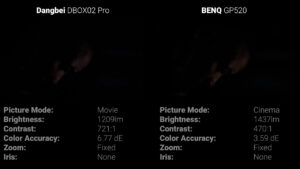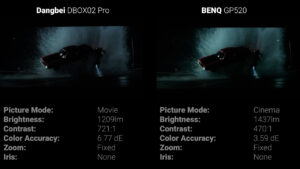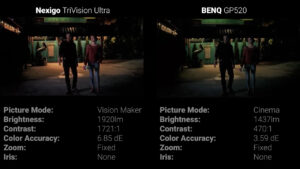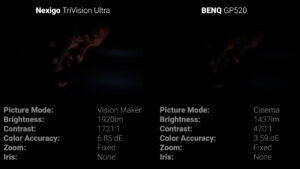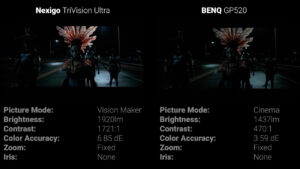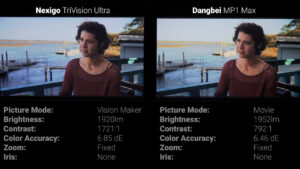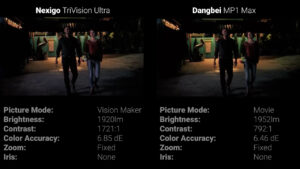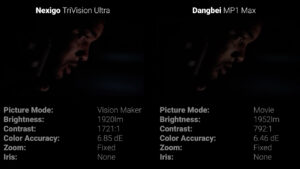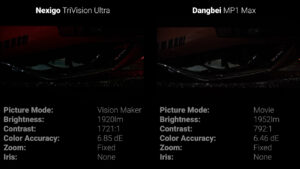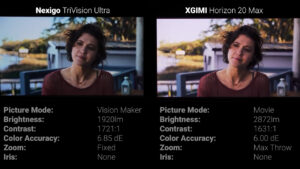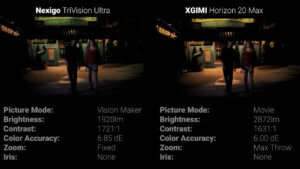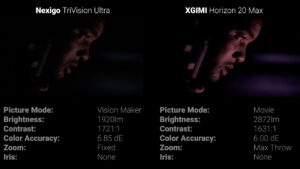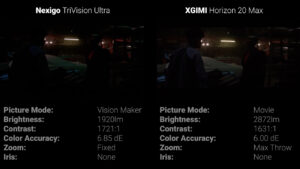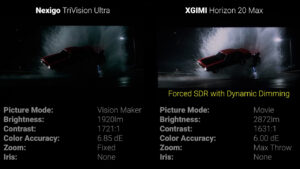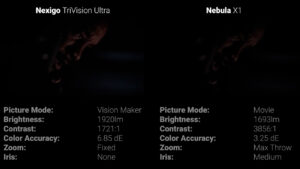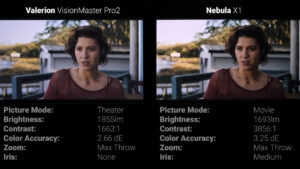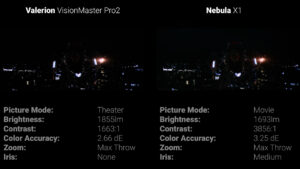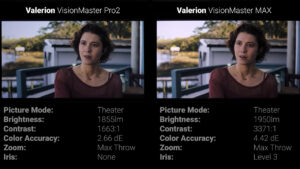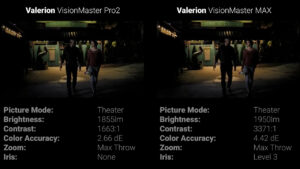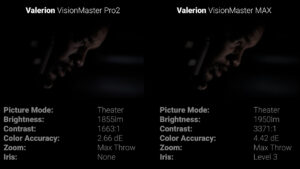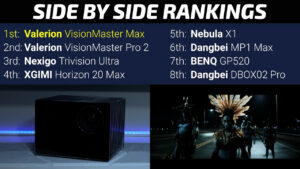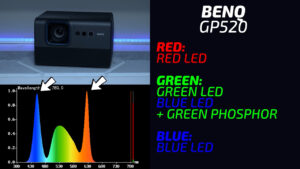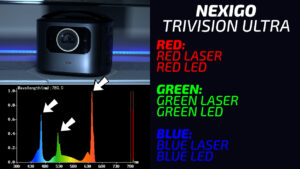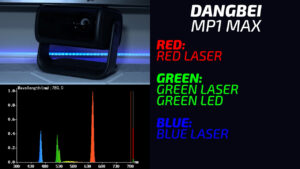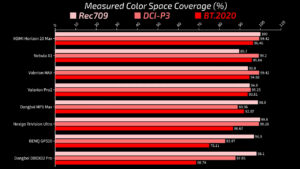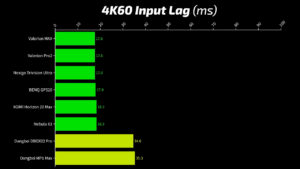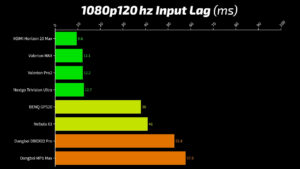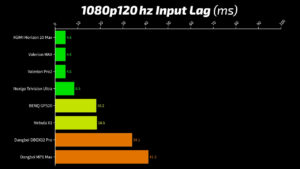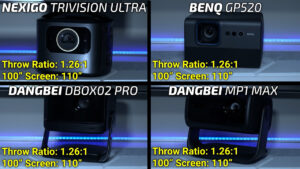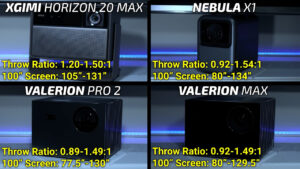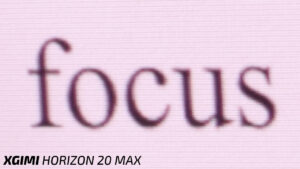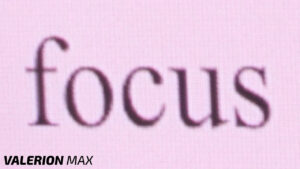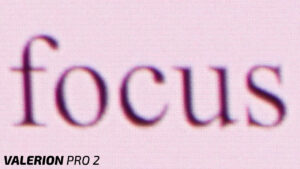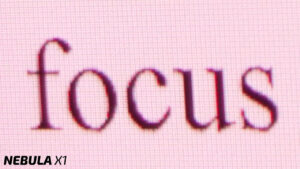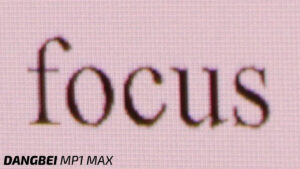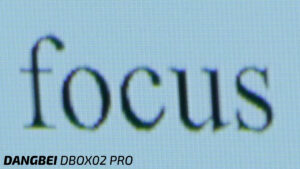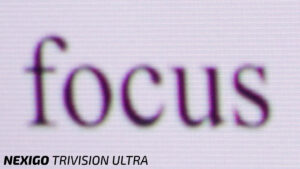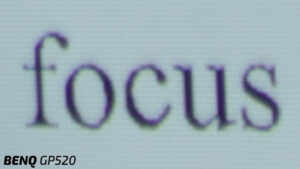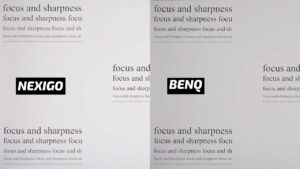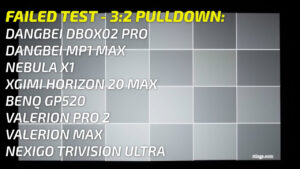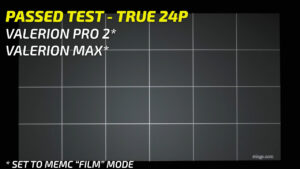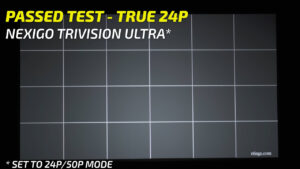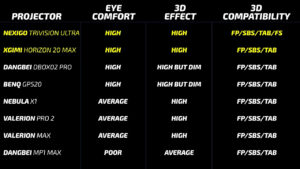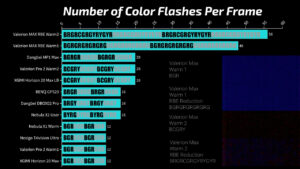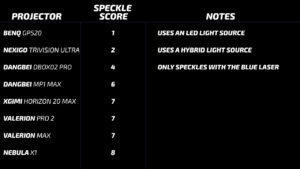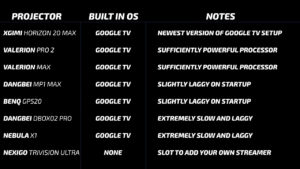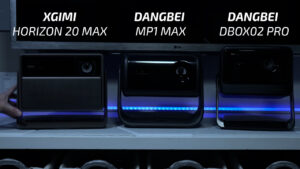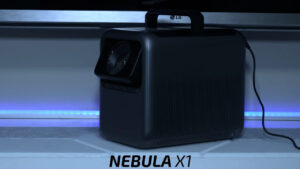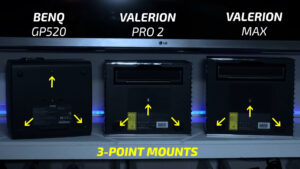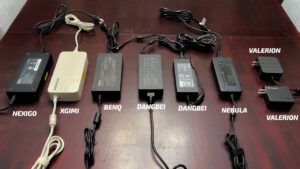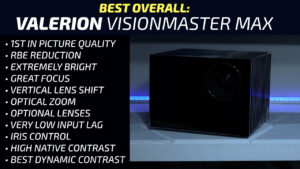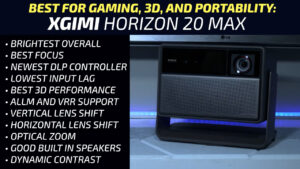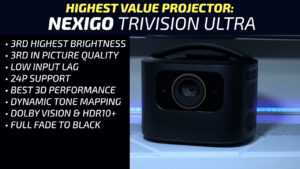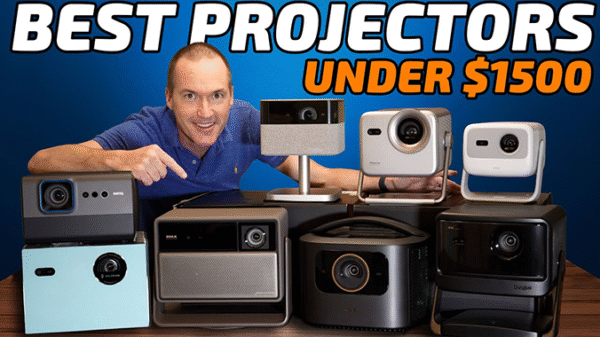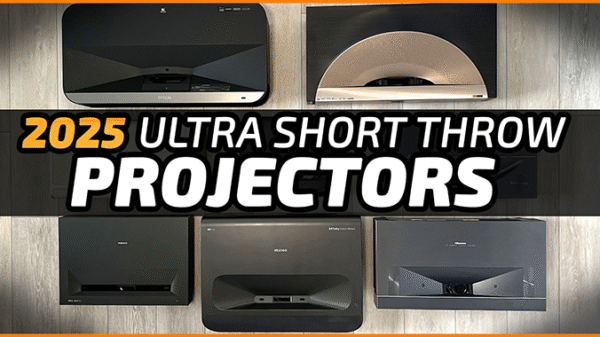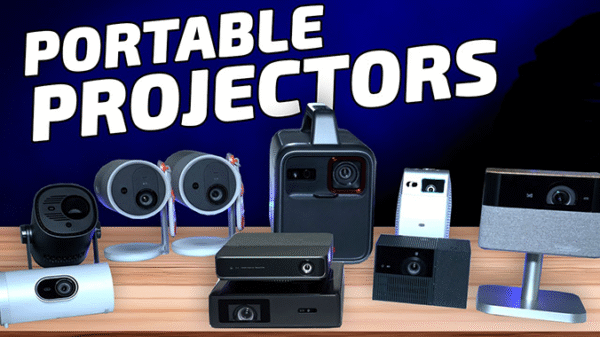Ultimate 4K Laser Projector Review 2025
September 26, 2025It’s officially projector review season, and in this review, I’ve got six highly anticipated standard throw 4K projectors from XGIMI, Nebula, Valerion, BenQ, and Dangbei, and I’ll be comparing them to the lower price point winner from 2024, the NexiGo TriVision Ultra and the landslide overall winner from last year, the Valerion VisionMaster Pro 2.
In this video I’ll measure their brightness, contrast, and color accuracy. Then I’ll put them head-to-head on 100” screens to judge picture quality. After that I’ll test input lag, focus and clarity, 3D performance, laser speckle, DLP rainbow effect, fan noise, and a lot more. As always, there are no sponsored reviews on this channel and all the measurements I’m going to give will be the result of my own testing rather than relying on manufacturer’s claims.
Brightness Testing
Starting out with brightness testing, as these projectors get more advanced with things like optical zoom, iris adjustments, and dynamic laser dimming, just measuring the maximum brightness and maximum contrast isn’t really that useful since they basically never happen at the same time and might not be in a mode you’d ever want to use.
But step one was just verifying brightness claims, which meant putting each projector in its brightest mode. If they had optical zoom I put them at their minimum throw distance, and if they had an adjustable iris, I put it at its wide-open setting before performing a 9-point ANSI/ISO lumen test where I take nine individual readings with my lux meter, average them, and multiply by the screen size in square meters. Here are the advertised maximum lumens for each projector, and here’s what I was able to measure as a maximum brightness.
Coming in at over 95% of its advertised 5700 lumens, the XGIMI Horizon 20 Max was by far the brightest projector hitting an insane 5423 lumens on High Power mode, but with the fans set to jet engine speeds and extremely inaccurate colors with an average delta error of 21.92. That story was pretty common, with the Dangbei MP1 exceeding its advertised brightness by 18 lumens in high power mode at the expense of fan noise and less color accuracy, though I could probably tolerate this level of accuracy for watching sports. Nebula X1 in conference mode hits 3022 lumens with reasonable fan noise, but unwatchable color accuracy. The Valerion Max puts up a very respectable 2938 lumens in standard mode, at minimum throw with no compromises in fan noise and color accuracy at 8.16 average delta error (dE), which is totally usable. Valerion Pro 2 needs to be on Brightness Enhancer 2 to hit 2824 lumens, which sacrifices color accuracy to an unusable level of 23.16 delta error. The NexiGo TriVision Ultra in Super Bright mode ramps up its fans to hit 2715 lumens, with a higher, but usable delta error of 10.03. The Dangbei DBOX02 Pro was by far the dimmest, hitting just 1802 lumens even on high power mode with its fans ramped up to the max. But the most ridiculous result was from the BenQ GP520 on Bright mode that seems to try to detect a mostly white screen and then switch to full power, but it is in no way usable, and it’s just a blatant attempt to try and game the measurement system.
Looking at usable brightness with no fan noise compromises and delta error under 10, the XGIMI Horizon 20 Max loses 1400 lumens but still comes out on top at 3073 lumens at minimum throw in Movie mode with a 6.64 dE. The Valerion Max was already usable at its maximum of 2938 lumens at 8.16 dE in Standard mode. The TriVision Ultra hits 2380 lumens in Vision Bright mode with 8.59 dE. Nebula X1 has 2018 lumens in Movie mode with a full open iris and a dE of 3.25. The Valerion Pro 2 hits 2007 lumens at minimum throw in Theater mode with a dE of 2.66. The Dangbei MP1 hits 1957 lumen in Movie mode with a dE of 6.46. The BenQ GP520 has 1437 lumen on Cinema mode with a dE of 3.59. And the DBOX02 Pro was the dimmest at 1209 lumen with a dE of 6.77.
Contrast Testing
Contrast is also a tricky subject, because on projectors with optical zoom, they will always be brightest at their minimum throw distance, but they’ll have more contrast at maximum throw.
Going from minimum throw to maximum throw, the XGIMI Horizon 20 loses 6.5% of its brightness, but gains 18.5% native contrast jumping from 1376:1 to 1631:1.
The Valerion Pro 2 loses 7.5% brightness to gain 42% native contrast up to 1663:1.
The Valerion Max loses about 7% brightness and gains a crazy 56% native contrast up to 2346:1.
And the Nebula X1 loses just 5.5% of its brightness to gain 55% native contrast bringing it all the way up to 2528:1.
The next feature that just recently started showing up on these 4K lifestyle projectors is a motorized iris, which works just like the iris on a camera and reduces the amount of light that can pass through by lowering the size of the aperture, which is just the hole that the light passes through in the lens. Smaller apertures have higher contrast and sharper focus, but it comes at the expense of overall brightness.
In this group the Valerion Max and Nebula X1 both have manual motorized iris, which means you’ll select an iris level that gets you the ideal tradeoff between brightness and contrast for your space, but unlike dynamic iris systems, the iris will not adjust itself scene by scene automatically.
The Valerion Max has six levels of iris plus iris 0, which is the wide-open setting. Keeping all settings the same, iris 0 has a native contrast of 2346:1, setting it to iris 3 results in a 33% decrease in brightness, but a 125% increase in native contrast up to 3371:1, and setting it to iris 6 cuts the brightness by 50%, but increases the native contrast by 180% all the way up to 4245:1.
The Nebula X1 has four steps of its iris in addition to the wide-open setting, and on iris medium, which is about equivalent to Valerion iris 3, the Nebula sacrificed 11% of its overall brightness for a 77% increase in contrast, bringing it from 2175:1 to 3856:1. On minimum iris, which is roughly equivalent to iris 6 on the Valerion, the X1’s brightness is reduced by 32%, for a 170% increase in contrast, maxing out at 5900:1 native, with a black floor of 0.08 lux which is basically unheard of for a DLP projector, especially under $3000.
The last feature that makes a huge difference in contrast measurements is being able to dynamically control the brightness of the laser or LED light source to dim it in scenarios where full brightness colors aren’t needed, which also has the effect of reducing the black floor.
While all of the contrast measurements so far have been more or less directly comparable because they represent the projector’s native contrast, dynamic contrast is much more complicated because not all dimming algorithms are created equal.
Judging only by test pattern measurements, the Nebula X1 set to minimum iris, maximum throw, and dynamic contrast 3 has an almost unbelievable dynamic contrast of 47,200:1, while the Valerion Max under similar conditions of maximum throw and iris 6 only has roughly half as much dynamic contrast at 23,350:1. The XGIMI Horizon 20 Max and Valerion Pro 2 also have dynamic modes that significantly increase their contrast beyond what a normal DLP projector could achieve, while the BenQ GP520 uses dynamic dimming to increase its native contrast of 470:1 up to around 1500:1. But that’s still less than the native contrast of several of these projectors, and like I said, the effectiveness of dynamic contrast depends on a lot of factors like the light source type, the projector’s processing power, and the programming of the dynamic contrast algorithm, and the only way to know how effective they are is to put them side-by-side watching actual content.
Side-by-Side Testing
Starting with the two least expensive projectors, I put the Dangbei DBOX02 Pro and BenQ GP520 side by side on two 100” 1.1 gain white screens in a light-controlled environment. Starting with SDR content, both projectors looked a little washed out as a result of their lower-than-average contrast ratios, and the Dangbei was definitely shifted more towards red than the BenQ, but neither projector was as saturated as I would prefer in this bright scene.
In dark content the BenQ’s dynamic contrast algorithm kicked in and resulted in a pretty decent performance in the darkest SDR scenes, but the same can’t be said for the Dangbei DBOX02 that not only had an extremely high black floor, but also completely crushed the shadow detail in this scene making it nearly unwatchable.
In HDR content, neither projector was very good, with the high black floor of the Dangbei making dark areas look muddy and gray, while the lack of HDR10 dynamic tone mapping on the BenQ led to an overly dim image with tons of lost shadow detail and very little vibrance and color pop. Ultimately, I chose the BenQ GP520 in this round, but I wasn’t particularly impressed with either of them.
In round 2 I put the NexiGo TriVision Ultra on the left and the BenQ GP520 on the right. The NexiGo is about 25% brighter and has more native contrast than the BenQ has dynamic, and you can see that in bright SDR scenes the NexiGo is so much more vibrant and appears to have much more depth due to that higher contrast ratio, but the delta error of 6.85 is also visible and the NexiGo is noticeably more blue than the BenQ, which despite looking kind of bland is surprisingly color accurate.
In dark scenes there was a pronounced difference between the two projectors since the TriVision keeps its light source at 100% brightness and relies on its native 1744:1 contrast ratio leading to very bright highlights but an ultimately raised black floor versus the BenQ which dynamically lowers the brightness of its light source leading to a low black floor but comparatively muted highlights. Ultimately, the NexiGo showed significantly more shadow detail, and I preferred it over the BenQ’s lower black floor.
In HDR content the NexiGo has the advantage of Dolby Vision support while the BenQ is just using standard HDR10, but despite its support for dynamic dimming, the BenQ was just far too dim in HDR to produce a vibrant image on a 100” screen. So, while I appreciated the low black floor, the TriVision Ultra was an easy pick in this round.
In round 3 the TriVision Ultra on the left goes up against the Dangbei MP1 Pro on the right. On the surface these are very evenly matched projectors, and both have hybrid light sources, around 1950 accurate ANSI lumens, and color delta errors around 6.5, but the NexiGo has the advantage of more than double the native contrast and support for Dolby Vision. Starting out with bright SDR content, in person I thought that the MP1 looked a little too green but watching it back that doesn’t seem to be the case and that’s a bit surprising to me because that’s normally an experience that I have with triple laser projectors and not hybrid light sources. So, that will need some further investigating and watching it back on video I think the MP1 looks better now, but in person I definitely favored the NexiGo TriVision Ultra in these bright scenes.
However, in dark scenes the lower contrast of the MP1 Max was problematic, and like the Dangbei DBOX02 Pro from round 1, the MP1 Max was muddy and washed out with a lot of missing shadow detail compared to the NexiGo.
In HDR content the Dangbei had plenty of brightness, but tone mapping was substantially better on the Dolby Vision implementation on the NexiGo versus the HDR10 on the Dangbei, and the image from the NexiGo was more vibrant and dramatic, even though it wasn’t quite as bright as the Dangbei. It also seemed like the Dangbei was using the SDR Rec709 color space for this HDR content, where it should have been using the P3 HDR color space, which caused the colors to be extremely undersaturated, and the more HDR content I watched the more it was obvious that the NexiGo TriVision Ultra won this round.
That makes round 4 the NexiGo TriVision Ultra on the left and the XGIMI Horizon 20 Max on the right. I’ve got to show some respect here, almost 3000 ANSI lumens in a color accurate movie mode is wild. I had to change my camera settings a little bit to correctly expose the XGIMI even at maximum throw distance. You can see that the nearly 2000 ANSI lumen NexiGo TriVision Ultra looks comparatively dim next to the XGIMI, and in bright SDR content the XGIMI looked more like a TV than a projector on a 100” screen. Again, in person, it looked a little green to me for reasons we’ll cover later, but on camera it looks very similar to the NexiGo, and there’s nothing about my color accuracy tests in Calman Ultimate that would suggest the XGIMI is green shifted.
I also had XGIMI’s Dynamic Black Level Enhancement on and there’s no doubt it was working and dimming the lasers to lower the black floor, but the resulting color balance was WAY off and everything turned dark blue when that dynamic mode kicked in. But honestly, it was good enough that I would be willing to forgive it, especially because I think it’s something that could be easily fixed in a future firmware update.
Unfortunately, there is a fatal flaw, and that’s that for some reason Dynamic Black Level Enhancement is completely disabled in all Dolby Vision Modes. Since the majority of content on streaming platforms these days comes in Dolby Vision, that means that one of the most important features of the Horizon 20 Max is unavailable most of the time.
I also turn on motion interpolation for filming because it helps prevent tearing when the camera’s framerate doesn’t match with the projectors, but for some reason MEMC was permanently disabled for Dolby Vision on the XGIMI, and similarly odd, it was permanently enabled and set to “medium” in SDR mode.
Overall, I was a huge fan of the extremely bright image on the XGIMI, and to be fair, this is a pre-production unit with a pre-production firmware, but overall there were just too many bugs related to picture quality and picture settings for me to move it through to the next round, so with some reservations I’m moving the TriVision Ultra on again.
Round 5 is the NexiGo TriVision Ultra on the left and the Nebula X1 on the right. Points immediately go to Nebula for picking a projector model name without Pro, Max, or Ultra in it. The Nebula is also, on paper, by far the best projector in this video with nearly 6000:1 native contrast, 47,000:1 dynamic contrast, and very respectable brightness. To best compare it with the NexiGo TriVision Ultra I set it to iris medium which gives it around 1700 lumens with double the native contrast of the NexiGo. In bright SDR content in person, I of course thought the Nebula looked too green because of how my eyes perceive pure RGB lasers, but again, on camera and on my testing equipment the Nebula is D65 color accurate. During bright scenes it also had excellent depth in shadowy areas like Dani’s hair thanks to its high native contrast. However, even though it has gotten better since it was first released, the dynamic contrast algorithm of the Nebula, which I had set to level 1 out of 3, leaves a lot to be desired. Unlike the systems from XGIMI, Hisense, and Valerion that can maintain bright highlights while decreasing the black floor, Nebula seems to dim the whole image, resulting in dimmer highlights, which are already reduced in brightness due to the iris.
You can see that despite having a lower black floor, the Nebula’s dark scene performance is not that impressive with a significant amount of lost shadow detail.
I also noticed in Dolby Vision content that the Nebula appeared to have less color saturation, and it wasn’t that it was using the wrong color space like the Dangbei, it just seemed like bright colors on the Nebula were muted compared to the vibrant image of the NexiGo.
I tried all the tricks that I know to make the Nebula’s picture live up to its specs like experimenting with gamma settings, increasing Dolby Vision screen size, trying different dynamic levels, and testing with the iris on minimum, maximum, and medium, and in maybe 5% of scenes the Nebula had a slight edge over the NexiGo, mostly due to its lower black floor, but the other 95% of the time I preferred the picture on the NexiGo. However, I already compared the NexiGo and Valerion Pro2 in last year’s video, so I’m going to provisionally move the Nebula X1 into the next round with the understanding that I personally preferred the image on the NexiGo.
That means that round 6 is the Valerion Pro 2 on the left and the Nebula X1 on the right. In bright SDR content the Valerion knocked it out of the park with bright highlights, excellent color accuracy, and tons of shadow detail. In comparison the Nebula looked slightly oversaturated making skin tones look a little strange, and in darker content the Valerion’s dynamic laser dimming algorithm showed why it is the best on the market. If we take a still frame you can see that the shadows and even the black bars on the Nebula are brighter than they are on the Valerion, even though the Valerion is still able to maintain brighter highlights in the background.
Throughout all content whether it was extremely bright like Planet Earth, or testing the limits of the black floor, the Valerion Pro 2 outperformed the Nebula X1 in terms of image processing, tone mapping, color accuracy, and even shadow detail, which is as disappointing as it is confusing considering how good the Nebula’s specs look on paper. There was no question that the Valerion Pro 2 was the winner in this round.
The final round then is Valerion vs Valerion, with the Pro 2 on the left and the new Valerion Max on the right. For this side by side, I’ve got the Valerion Max on iris level 3, which gives it slightly higher brightness than the Pro 2 at 1950 lumens and about double the native contrast at 3371:1. Both are set to their highest enhanced black level setting, which is called High Dynamic Range on the Pro 2 and EBL High on the Max.
Unlike the previous round with the Nebula, the significantly higher native contrast of the Valerion Max was easily visible in every scene with a lower black floor, better shadow detail, and more perceived clarity and sharpness in those shadowy areas. I also thought the slightly more saturated picture on the Max made everything look a bit more interesting without making skin tones look strange like they did on the Nebula, but the Max did have lower color accuracy than the Pro 2 with a dE of 4.42 compared to 2.66.
Occasionally the Max really came through and showed off some truly impressive black levels and contrast, but for the most part the Max was just ever so slightly better than the Pro 2 in every scene, and unfortunately for Valerion, I think the thing that is going to prevent most people from buying the Max is the fact that the Pro 2 is nearly as good for significantly less money.
Side-by-Side Final Rankings
Still, I’m sure Valerion won’t be sad to see that they’ve taken the top two spots in the side-by-side testing. I put the NexiGo TriVision Ultra in 3rd, but I think the XGIMI Horizon 20 Max could easily take 3rd place once they get their software figured out, and it could even overtake the Valerion Pro 2 if they could match the dynamic dimming effectiveness of Valerion’s EBL, but that doesn’t seem to be an easy thing to do.
Color Accuracy
But it’s honestly overwhelming how much more there is to test on these projectors. The first thing I need to address is color accuracy, because as I mentioned, all of the triple laser projectors look green to me in person but when I measure them with my very expensive JETI 1501 Hi-Res spectroradiometer with a 2 nm optical bandwidth, they appear to be very accurate with no green bias at all.
To understand what’s going on we need to look at the spectral distribution of a pure white signal on each projector, and I know this sounds sciency for a projector review but stick with me.
In this video the BenQ is the only one using an LED light source, specifically BenQ’s 4LED light engine, and as a result you can see two narrower peaks for red and blue that are each driven by single color LEDs, and then a much wider peak for green that’s driven by two blue LEDs shined through a phosphor to create green.
Similarly, the Dangbei DBOX02 Pro is using a dual laser setup with a blue and red laser for red and blue primaries, and then a phosphor wheel to produce greens and a wider range of reds.
The NexiGo TriVision Ultra has what they call the ALPD5.0 hybrid light source that uses a separate laser for red, green, and blue which are the narrow peaks, but then it also uses red, green, and blue LEDs that give the much wider spectral distribution.
The Dangbei MP1 Max is also supposed to use a hybrid light source, but you can see that compared to the NexiGo there’s just this little, tiny bump around the green wavelengths, so the MP1 is mostly just a triple laser projector rather than a true hybrid.
Then the XGIMI Horizon 20 Max, Nebula X1, Valerion Pro 2, and Valerion Max are all pure triple laser projectors with narrow, steep peaks, especially the red laser which results in extremely wide color space coverage and vibrant super saturated colors. But for me, my eyes can’t see that narrow red peak as well as my $7000 spectroradiometer, so even though it says the colors are accurate everything looks a bit too green to me because I don’t see as much red. My problem is not unique with about 8% of men and 1% of women worldwide showing at least minor red deficiencies.
Even people without color blindness seem to perceive the white balance from triple laser projectors slightly differently. The most recent recommendations are to calibrate these projectors to a white point between 7000 K and 7500 K instead of 6500 K which has been the standard in theaters since the early 90s.
The point is, triple laser projectors produce a dazzling image that you really have to experience to understand, but they may look different to you based on individual differences in your eyes. If you plan on watching your projector with a large group of people there’s a good chance they won’t all perceive the same colors, and hybrid light sources and LED light sources will tend to look more similar to more people regardless of differences in physiology.
The other thing that has a huge effect on color accuracy is whether the projector correctly identifies and displays the color space that the content is supposed to be in, and if you’ve ever heard a projector say it can “produce 140% of the P3 color space,” that’s not necessarily a good thing. In order for the colors to look right the projector needs to limit the colors to the intended color space.
On most projectors you’ll see a color space option that lets you choose between things like Auto, BT2020, P3, 709, on, off, and native. They don’t always do the same thing, but in general picking a single color space like BT2020, P3, or 709 is a bad idea because it will force the projector to always use that color space even if the content is made for a different one. “On” usually uses the sources color space and “Auto” usually does the same, while “Off” and “Native” will use the maximum color space that the projector can produce.
In this video, the DBOX02 Pro’s blue primary was way outside of the SDR color space, the Dangbei MP1 Max in movie mode is limited to the P3 color space even when the content calls for the large BT2020 color space, while the standard HDR10 mode uses the projector’s full native color gamut for HDR.
The Nebula X1 overshoots the color space on all HDR content and defaults to the largest BT2020 color space when “Auto” or “On” are selected and uses its native color space when “Off” is selected, but it does use the correct color when displaying Dolby Vision content.
The BenQ GP520, NexiGo TriVision Ultra, XGIMI Horizon 20 Max, and both Valerion projectors correctly limit and display the correct colors based on what the content is mastered in, although the BenQ’s LED light source is only able to produce around 75% of BT2020 compared to 87% for the NexiGo’s hybrid light source, and over 90% for all of the triple laser projectors.
Input Lag
Moving on to input lag which is important if you plan to play video games on your projector, in general input lag values under 20 ms are great for all games, between 20-50 ms is okay for casual gaming, from 50-100 ms will start to feel strange, and input lag above 100 ms is not acceptable for gaming.
Using the industry standard Leo Bodnar lag tester I measured each projector at 4K60Hz, 1080p120Hz, and 1080p240Hz and found that at 4K60Hz which is what most people will use for gaming all of the projectors except the Dangbei MP1 Max and DBOX2 Pro were under 20 ms with the Valerions and NexiGo locked at 17.6 ms, the BenQ GP520 was just slightly more than that, and the Nebula and XGIMI measured 18.3 ms, sort of.
Thanks to the newest DLP controller from Texas Instruments, the XGIMI is the first projector to the market that refreshes its screen from top to bottom instead of all at once, which means that if you measure input lag at the top of the screen it can be as low as 2 ms, even at 4K60Hz, and it’s also the first DLP projector to fully support variable refresh rate or VRR.
At 1080p120Hz only the XGIMI, Valerion, and NexiGo projectors improved their input lag, and the rest of the projectors had unstable input lag measurements which suggests they are dropping frames and not outputting the full 120fps.
The same was true at 1080p240Hz where the XGIMI, Valerion, and NexiGo projectors all improved again, and at 240Hz I was able to measure input lag under 1 ms for the first time ever on a projector if I put the probe at the very top of the screen. Don’t forget that DLP mirrors have instant refresh rate, so there’s virtually zero motion blur at 240Hz making this new XGIMI projector not only the best projector on the market for gaming, but also one of the best gaming displays period.
I spent an entire day gaming on the XGIMI, Valerion, and NexiGo projectors and for games like Silksong where input lag is important but there’s no fast camera movements, I couldn’t tell much of a difference other than the Valerion’s black levels being noticeably better and the XGIMI being brighter and more vibrant. But in Doom: Eternal at 1080p120Hz the XGIMI Horizon 20 Max on a 150” was the clearest motion I’ve ever seen during fast camera panning, and input lag was basically nonexistent.
Image Positioning (zoom, lens shift)
Another area where the Valerion Max and XGIMI Horizon 20 Max are in a league of their own is with image positioning. The NexiGo, BenQ, and the two Dangbei projectors all have fixed throw distances, so you’ll need to mount your projector at the exact right distance for your screen size, or you’ll be forced to use digital zoom. The XGIMI, Nebula, and both Valerion projectors have optical zoom, so you’ll get a little bit of flexibility in the distance where you need to place your projector, but remember that placing it further away from the screen will give you better contrast, and closer will give you more brightness, and last the Valerion Max and XGIMI Horizon 20 Max both also include vertical lens shift, which can move the projected image up and down without any image degradation or increase in input lag, and the XGIMI also has horizontal lens shift to move the image from left to right.
All of the projectors have digital keystone and digital zoom functionality, but those will ultimately lower image quality, increase input lag, and give a halo of projected light around the screen where the original non-keystoned image was.
Focus and Clarity
That brings me to lens quality and clarity. With these projectors there are three general issues that you can run into. The first is called the screen door effect (SDE) where you can see the spaces in between the pixels, the second is chromatic aberration which is when there is color fringing around black lines, and the third is focus uniformity where it’s not possible to get the whole screen in perfect focus at the same time.
To test all of these I projected this image onto a 120” matte white screen and took close up pictures of the middle and each corner of the screen.
Starting with SDE and chromatic aberration, the XGIMI Horizon 20 Max had the best overall focus with zero chromatic aberration, low screen door effect, and very good overall focus.
The Valerion Max was in second with a small amount of red fringing and slightly more screen door effect than the XGIMI, but sharper overall focus.
After that was the Pro 2 with slightly more fringing, but less screen door effect.
Then the Nebula X1 had very crisp focus but a lot of SDE and more noticeable red fringing.
The Dangbei MP1 had red, yellow, and teal color fringing and a noticeable pixel grid.
The Dangbei DBOX02’s fringing was green and blue, and focus was just a little soft overall.
The NexiGo had red fringing and overall soft focus while still having visible SDE.
And the worst focus was from the BenQ that was blurry with green and red fringing.
In terms of corner focus, all of the projectors were actually very good except the NexiGo and BenQ which had slight blurriness in the top corners when the middle focus was perfectly dialed in, but both were still sharp enough that you’d never notice while watching actual content.
I also threw in one last lens quality test because I noticed some light leakage from the Dangbei DBOX02 Pro and Nebula X1 while doing side-by-side testing. So, I massively overexposed my camera and projected a small completely black image onto my 150” white screen to reveal the light leakage pattern. Just as I suspected the DBOX02 Pro had the most pronounced light leakage, followed by the Nebula X1, then the NexiGo TriVision Ultra, Valerion Pro 2, then the new XGIMI Horizon 20 Max, then the Valerion Max, and the Dangbei MP1 and BenQ had very close to zero light leakage. As I said I only noticed it on the Dangbei DBOX02 and Nebula X1 during actual content.
Lastly, while we’re talking about lenses, one of the advantages of the Valerion Max over the Pro 2 is the ability to use add-on lenses. Valerion will be selling this long throw lens starting Q1 2026 which increases the throw ratio from the stock 0.9-1.5:1 up to a max of 2.0:1 which means you can place the projector further back if you’re using it in a long, dedicated theater room.
24p Motion
Speaking of dedicated theater rooms, if you’re a movie buff you probably know all about 24p motion and the trouble that some projectors can have with both motion judder and motion stutter. So, my first test was to figure out which projectors can faithfully display 24p content using the RTINGS 24p test. All of the projectors will display 24p content at 60Hz with 3:2 pulldown by default which can cause motion judder, but the Valerion projectors can be set to MEMC – Film setting which accurately displays 24p motion, and the NexiGo TriVision Ultra can toggle 24p mode which also passes the RTINGS 24p motion test.
3D Performance
Lots of movie buffs are also 3D enthusiasts and DLP projectors are basically the last fully supported way to consume 3D content on a big screen. I spent a few hours testing all types of 3D on these projectors and I rated them in three categories which were eye comfort, 3D effects, and 3D compatibility.
The top 3D performers were the XGIMI Horizon 20 Max and NexiGo TriVision Ultra which both had excellent 3D effects and good eye comfort, as well as high compatibility. But the TriVision Ultra had a slightly better menu for accessing 3D settings, and supports Frame Sequential 3D as well as frame packing, side by side, and top and bottom.
Both the Dangbei DBOX02 and BenQ GP520 were also excellent in terms of 3D effect and eye comfort but were significantly dimmer than the NexiGo and XGIMI.
The Nebula X1, Valerion Max, and Valerion Pro 2 all had good 3D effects and compatibility but less eye comfort.
The Dangbei MP1 was the least comfortable for me to watch and made me feel cross-eyed after just a few minutes, which will probably require a firmware update to fix.
DLP Rainbow Effect
On the subject of comfort, we can’t talk about DLP projectors without mentioning the DLP rainbow effect, or RBE, which is the tendency for high contrast fast moving objects to look like they have a rainbow border. This effect is due to the fact that a DLP projector flashes each color sequentially instead of simultaneously like on a three-chip projector like an Epson or high-end JVC, and in the past, I’ve just put on my RBE inducing test pattern and subjectively rated each projector based on my own RBE perception. But this year I decided to step it up and buy a high-speed camera that can record at 40,000 frames per second so I can give a quantitative measurement for RBE tendency. This is my first of these tests so it’s possible there’s another underlying factor like the number of black flashes per frame or type of light source, but for the most part, the more individual color changes there are per frame the less RBE the projector should have.
Here’s what I found. The Valerion Max with the RBE reduction feature does a staggering 56 color changes per frame on Warm2 and 48 on Warm 1. The Dangbei MP1 Max and Valerion Max and Pro 2 on Warm2 without RBE reduction had the next highest number of color changes at 20 per frame, the Dangbei DBOX02, BenQ GP520, XGIMI Horizon 20 Max with luminance boost enabled, and Nebula X1 on Standard mode with user white balance all have 16 changes per frame, and the TriVision Ultra, XGIMI Horizon 20 Max, Nebula X1 on Warm white balance, and both Valerion projectors on Warm1 without RBE reduction all have 12 cycles per frame, which is what used to be called a standard 4x color wheel, even though they are using lasers now, and those modes are where you can expect to see the most rainbow effect.
Laser Speckle
Speaking of laser light sources, they’ve got a lot of benefits like high color volume, better focus, and higher brightness and efficiency, but their major downside is something called laser speckle which looks like a glittery interference pattern on the screen. To judge this, I pulled out my most speckle prone screen, the VividStorm Fusion ALR, and rated each projector’s tendency to produce speckle out of 10 with 10 being unwatchable speckle and 1 being no speckle at all.
The Nebula X1 had ever so slightly more speckle than the Valerion and XGIMI pure RGB laser projectors. The Dangbei MP1’s hybrid light source was slightly better than a pure RGB source, but not much. The Dangbei DBOX02 Pro’s dual laser light source had almost zero speckle except when it was displaying a pure blue screen. The NexiGo’s TriVision Ultra’s hybrid light source showed just the smallest amount of speckle possible on this very speckle prone screen. Lastly, the BenQ had no speckle as a result of not using lasers at all. And if you’re wondering why speckle matters, it basically just limits you in the type of screen that you can use with your projector. High texture screens like acoustically transparent screens and spandex screens almost completely eliminate speckle while smooth and highly reflective screens like some ALR screens can make speckle much worse. So, if you’re dead set on using an ALR screen or you already own a forever screen that is incompatible, you may want to consider something other than a pure RGB laser projector.
Fan Noise & Speakers
We also need to briefly talk about fan noise and speaker quality and here are the fan noise levels on highest laser power from loudest to quietest, which were almost all at or below the sound floor of my testing room.
For speaker quality, everyone always skips this portion of my video because I think most people spending over $1000 on a projector will also use a sound system. So, instead of recording each projector I just ran a frequency response sweep that you can see here. Here are the ranks from best sound to worst, with the Nebula X1 coming out on top with its optional wireless speaker accessory that lets you put the projector behind you and the speakers in front of you for outdoor movie nights.
Built-in Operation System
Built-in OS is another thing that most people probably won’t use, but I encountered some things in my testing that definitely need to be mentioned, specifically that the Nebula X1 and Dangbei DBOX02 Pro’s processors seem way too underpowered to handle Google TV and they were both unacceptably laggy. The Dangbei MP1 and BenQ GP520 were slightly better, but still a little laggy, while the Valerion Pro 2, Valerion Max, and XGIMI Horizon 20 Max were all very snappy and responsive. The NexiGo TriVision Ultra doesn’t include a built-in operating system at all and instead has a slot under the projector to install a Fire TV stick, which I personally think is the best solution.
Form Factors
Very last before I draw some final conclusions, I want to cover form factor and remotes. The XGIMI Horizon 20 Max, Dangbei MP1 Max, and Dangbei DBOX02 Pro all have built-in gimbal stands which are great if you plan on moving your projector around a lot and setting it up in temporary places but can be a bit annoying if you plan on permanently mounting them. The Nebula X1 has a motorized gimbal lens that can tilt up, which has the advantage of not moving if it gets bumped, but is harder to adjust since it needs to be done with the remote and can’t tilt down like a standard gimbal. The BenQ, Valerion Pro 2 and Max all have optional gimbal stands with single mounting screws, while the NexiGo TriVision Ultra is the only projector in this video that can use a center tripod mount, or a standard 4-point projector mount if you unscrew the leveling feet.
It’s also worth noting that with the exception of the Valerion projectors, the power bricks for these are absolutely massive, with the XGIMI, NexiGo, and BenQ in a tie for the largest, while the Valerion’s GaN power supply is tiny in comparison, but I do wish that the Valerion’s cable were 2-3 feet longer than it currently is.
On the subject of remotes, the Valerion and NexiGo remotes are by far the best with lighted keys and ample buttons for accessing all of the settings that you need. The BenQ, XGIMI, and Nebula remotes are passable, but there needs to be a better way to access the projector sub menu in Google TV where a lot of important settings are buried. The Dangbei remotes are almost unacceptably bad, and in order to access picture settings you have to press the side button, then scroll down to Google TV settings, and then select picture settings, and similarly to change sources you’ll need to hit the side button, then Google TV settings, select sources, and then scroll to your desired input.
Conclusions
Alright, that was a ridiculously long video, but thankfully the conclusions are straightforward.
First, if you are buying a projector for your home theater and you’re looking at things like the Epson LS11000, 12000, or 5050UB, you should forget about those and buy the Valerion Max instead. Last year when I tested the Valerion Pro 2 I said it was basically flawless and the Max has taken that solid baseline performance of the Pro 2, added an iris for increased contrast, vertical lens shift for flexibility in placement, and an RBE reduction feature that more than triples the color cycles per frame. To my eye they’ve also eliminated the color shifts with EBL that were introduced with the EBL high and low update, and the Max also adds another layer of flexibility with the external lens mounting system, so if the Max is in your budget and you need the flexibility, it’s basically a no brainer.
Unfortunately for Valerion, the Max’s biggest competitor is the Pro 2, which still performs exceptionally well, but for a lot less money based on the current sale prices listed on the Valerion website. So, if you don’t need lens shift or an external lens, it’s pretty hard to justify the significant price increase of the Valerion Max which makes the Pro 2 the right projector for most people’s home theaters based on value alone.
If your setup is a bit more casual and you plan on putting your projector on a table or shelf, if you are mostly using your projector for video games with fast camera movements, or if 3D performance is at the top of your wish list, then the XGIMI Horizon 20 Max is also incredibly good. Even though it couldn’t touch its 5700 lumens claim in any usable mode, it still had over 3000 ANSI lumens with acceptable color accuracy. If they can figure out how to fix their dynamic black level enhancement setting, the Horizon 20 is going to be a serious competitor for the Valerion Pro 2 in a theater environment as well. As firmware updates roll out for the XGIMI I’ll be putting update videos on my 2nd channel.
If you’re on a budget, the NexiGo TriVision Ultra currently priced at under $1300 is hands down the highest value projector on the market, with the 3rd highest usable lumens, and also finishing 3rd overall in my side-by-side testing with low input lag, 24p support, great 3D, dynamic tone mapping, Dolby Vision and HDR10+ support, and it just got a firmware update to add laser brightness controls and full fade to black. Unfortunately for the Dangbei MP1 Max, DBOX02 Pro, and BenQ GP520, the existence of the TriVision Ultra makes it really hard to recommend anything else in that $1500 and under price range unless a built-in gimbal and Google TV are on your must have list, in which case the Dangbei MP1 is probably the way to go.
As for the Nebula X1, I really think that Nebula needs to pick a direction because its feature set and form factor just don’t make sense. On the outside it’s got a rugged look and retractable handle which indicates it’s for outdoor movie nights, but the inclusion of an iris and their focus on contrast would fit better in a home theater. It’s got external wireless speakers for portability, but a sluggish built-in operating system, so you’ll probably want to pack your own streaming stick. The motorized gimbal is better for permanent mounting, but it’s harder to use in temporary setups than a traditional gimbal, and confusingly Nebula also sells an optional gimbal so your gimbal can have a gimbal. As I said, I just can’t think of a use case where the Nebula X1 is the best option even though it looks great on paper.
As always there are no sponsored reviews on this channel, but I do have links for all these projectors below, and as always, I appreciate when you use those links since as an Amazon Affiliate, I do earn a small commission on the sale at no cost to you.
I’d also like to thank all of my awesome patrons over at Patreon for their continued support, and if you’re interested in supporting my channel please check out the links below. If you enjoyed this video, please consider subscribing to my YouTube channel and as always, thanks for watching The Hook Up.
Best Overall: Valerion VisionMaster Max
- (Direct) https://tidd.ly/3KtLQqN
- (Amazon) https://amzn.to/443Osmc
Best For Most Home Theaters: Valerion VisionMaster Pro 2
Best For 3D, Gaming, and Family Room Setups: XGIMI Horizon 20 Max
Best Budget Option (Highest Value): NexiGo TriVision Ultra
Other Projectors Tested
- Dangbei MP1 Max: https://amzn.to/4nzfZTV
- Nebula X1: https://amzn.to/4n0N0bI
- BenQ GP520: https://amzn.to/46yr3Ki
- Dangbei DBOX02 Pro: https://amzn.to/4ntXb8u


